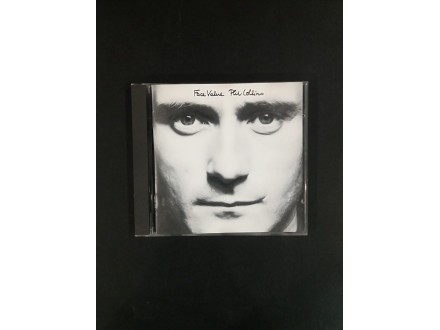Phil Collins - Face Value
| Cena: |
| Stanje: | Polovan bez oštećenja |
| Garancija: | Ne |
| Isporuka: | Pošta Post Express Lično preuzimanje |
| Plaćanje: | Tekući račun (pre slanja) Lično |
| Grad: |
Novi Sad, Novi Sad |
Izdavač: Ostalo
Žanr: Pop, Rok
Poreklo: Strani izvođač
Original, made in Germany
Knjizica od 12 str.
knjizica 5 Cd 4/4+
Face Value is the debut studio album by English drummer and singer-songwriter Phil Collins, released on 13 February 1981 by Virgin Records.[9][10] After his first wife filed for divorce in 1979, Collins began to write songs during a break in activity from Genesis with much of the material concerning his personal life. The album was recorded from mid-1980 to early 1981 with Collins and Hugh Padgham as producers. Additional musicians include the Phenix Horns, Alphonso Johnson, and Eric Clapton.
Face Value was an instant commercial success and reached No. 1 on the UK Albums Chart for three weeks and No. 7 on the US Billboard 200. It has since sold over 5 million copies in the US and over 1.5 million in the UK. The album received widespread praise from critics. Its lead single `In the Air Tonight`, released in January 1981, reached No. 2 on the UK Singles Chart and became known for its drum arrangement and use of gated reverb. In January 2016, Face Value was reissued with bonus tracks and new photography in the style of the original but featuring a present-day Collins.[11]
Studio album by Phil Collins
Released 13 February 1981
Recorded 1979 (demos)
August–December 1980 (overdubs and mix)[1]
Studio
The Town House, London
Old Croft, Shalford, Surrey
The Village Recorder, Los Angeles
Genre
Pop rock[2]R&B[3]art rock[4]experimental popnew wavesoft rock
Length 47:49
Label Virgin (UK)
Atlantic (North America)
WEA (elsewhere)
Producer
Phil CollinsHugh Padgham
Background and writing
By 1978, Phil Collins had been a member of English progressive rock band Genesis for almost eight years. After spending the first five as their drummer, he reluctantly accepted the role of frontman of the group in 1975 following the departure of the band`s original singer, Peter Gabriel. Three years later, after departure of guitarist Steve Hackett, Genesis` nine-month world tour to promote ...And Then There Were Three... (1978)[12] became problematic for Collins`s wife Andrea who complained that he was not at home enough and that should he commit to the full tour, she would not be there when he returned.[13] Collins, however, maintained that the band were on the cusp of international breakthrough and the tour would pay dividends for the future.[14] However, at the end of the tour, Andrea decided to take their two children to her parents in Vancouver, Canada. In an attempt to save his marriage, Collins moved to Vancouver, but the attempt failed. Collins returned to England in April 1979, with Andrea having agreed to return with the children.[12][15]
With Genesis members Tony Banks and Mike Rutherford working on their solo albums through 1979, Collins used some of his spare time to write songs. He told Modern Drummer early that year:
One ambition is to do my own album which will have a lot of variety. I write songy [sic] stuff, as well as some from the Brand X area. I`m also hip to what [Brian] Eno does - those kind of soundtracks which I`ve always been interested in - two or three minutes of just mood. The album, when it does come out, will have a lot of different styles on it.[16]
In his home in Shalford, Surrey, named Old Croft, Collins set up a Sequential Prophet-5 synthesiser, piano, Roland CR-78 drum machine, and an 8-track tape machine in his bedroom, and recorded a collection of demos with backing tracks and early lyrics.[17] He was not concerned with the quality of the recordings as what may have lacked in the recordings would have been salvaged with the emotion in the songs. There were numerous times where Collins stopped recording earlier than planned as the ideas were not working in the studio, leaving him to resume the following day.[18] Collins based the majority of Face Value on the divorce he had endured, and used a solo album as an outlet for his feelings.[18]
During the conception of the album, Collins had forged a close friendship with John Martyn and contributed towards Grace and Danger (1980), which contained a similar narrative relating to divorce and relationship breakdown. Some of Collins` material that he had written was performed by Genesis on Duke (1980), including `Misunderstanding`, the arrangement of which remained unchanged.[18] He had played `In the Air Tonight` and `If Leaving Me is Easy` to the group, but they were left out as Collins said they were `too simple for the band`.[18]
Early album titles included Interiors and Exposure.[18] To release the album, Collins signed a solo contract with Virgin Records for UK distribution.[17] He did so to `leave the nest` and to ensure he could maintain full creative control over the music. Collins also felt that releasing the album on Charisma Records, the same label as Genesis, would have harmed its success due to the preconceived notions people have about bands and labels.[17] Collins thought a new label would benefit the casual listener and appeal to a wider audience.[18] Virgin gave Collins a £65,000 advance on the album.[19]
Production
Recording
Recording sessions for Face Value took place at the Town House in London and the Village Recorder in Los Angeles between August and December 1980. The demos recorded onto 8-track were transferred onto 24-track.[17] According to Classic Albums, in what was considered a controversial move at the time, Collins, who grew up listening to American R&B as a child in Chiswick, decided to incorporate an R&B horn section, hiring the Phenix Horns, who played backup for Earth, Wind & Fire. Collins had asked a contact who knew the group if they were interested in playing, and upon their agreement their leader Thomas `Tom Tom 84` Washington met with Collins who asked him to sing the sections where the horns were to be placed into a tape recorder. The group recorded their parts the following day.[17]
Collins produced the album himself with assistance from Hugh Padgham, who would co-produce several of Collins and Genesis`s subsequent albums in the 1980s. Initially he considered George Clinton, Maurice White, or Phil Ramone until he realised that he merely wanted someone to endorse his own ideas.[18] Assistant recording engineer Nick Launay was hired after Collins was impressed with his work with Public Image Limited.[20] Collins was dissatisfied with initial test cuts of the album, describing them like a Queen album, `big, British and upfront`.[18] He then listened to several albums by black musicians including ones by The Jacksons and a collection of soul artists in his own collection, and noticed a common link with technician Mike Reece who worked at a Los Angeles mastering lab. Reece prepared a cut which Collins was satisfied with.[18]
Songs
The simple style of music on Face Value was reasoned by Collins as his fondness of Weather Report`s simple melodies and for black music.[18] Collins controversially included drum programming rather than just live drum instrumentation despite his reputation as a drummer. Collins said he wanted to experiment with different sounds and was inspired by the work of his former bandmate Peter Gabriel, who had used drum programming on his last album; Collins was part of these sessions. Many of the songs` arrangements were done by Collins and session arranger Thomas `Tom Tom 84` Washington. He incorporated Indian-styled violins, played by L. Shankar, for additional textures.
The last recording session for Face Value was in January 1981, prior to the release of the first single, `In the Air Tonight`. Atlantic CEO Ahmet Ertegun advised Collins to perform drums during the verses and opening of the song, whereas the album version does not feature live drumming until the bridge.[citation needed]
The album features songs of different genres. While technically a rock and pop offering, the basis of many of the tracks lies in R&B with light funk influences, especially in `I`m Not Moving`, for which Collins sang his backgrounds with a vocoder. `Droned` and `Hand in Hand` are progressive rock instrumentals, with the first featuring an Indian raga sound, while `Hand in Hand` features jazz elements, a black children`s choir from Los Angeles humming the music, and improvisational instrumentation by Collins and the Phenix Horns.[18] `The Roof Is Leaking` has Delta blues and country elements. `Behind the Lines` was originally recorded by Genesis on Duke album as a progressive rock number. Collins worked up a horn-driven R&B/funk-inspired arrangement after speeding up the tape on the Genesis version and thinking that the sped-up version sounded like a Michael Jackson song. The cover of The Beatles` `Tomorrow Never Knows` includes instruments and vocals playing in reverse while Collins provided multi-layered background vocals and sparse drumming. After the song ends, Collins can be heard quietly singing `Over the Rainbow` in reference to the recent murder of John Lennon; this final song is unlisted on most releases of the album (the original US cassette version being an exception), and would be the only time Collins used a hidden track on one of his own releases.
Four songs that Collins wrote during the Face Value sessions were ultimately omitted: `Misunderstanding` and `Please Don`t Ask` which appeared in the Genesis album Duke, `How Can You Just Sit There` (which evolved into his 1984 single `Against All Odds (Take a Look at Me Now)`), and what would become `Don`t Lose My Number`, which would not appear until Collins` third album No Jacket Required in 1985.
Packaging
Collins regarded Face Value as a highly personal project, which gave rise to the iconic cover art with Collins` face in extreme close-up, originally intended to symbolise the listener `getting into his head`; the reverse side of the sleeve shows the rear of his head, although the CD version of the album placed this image on the insert card instead. To emphasise the personal nature of the album, Collins also hand wrote all of the liner and sleeve notes, even down to the legal statements on the outer circumference of the centre label of the disc itself. Both of the main visual elements of Face Value — the facial close-up, and the handwritten notes — would become a motif of Collins` subsequent albums until 1996`s Dance into the Light. When crediting the musicians in the liner notes, rather than write `Phil Collins`, Collins simply wrote `Me`, although in future albums he would write his initials `PC`.[17]
Commercial performance
Face Value became an immediate success, reaching No. 1 in the UK, Canada, and other European countries, while peaking in the top ten in the US. `In the Air Tonight` became the album`s biggest hit, reaching No. 2 in the UK, No. 1 in three other countries, and becoming a top twenty hit in the US. Other songs such as `I Missed Again` found modest success reaching No. 14 in the UK and No. 19 in the US, while the third single, `If Leaving Me Is Easy`, reached No. 17 in the UK but was not released in America. Sales of the album reached five million in the US and went five-times platinum in the UK and ten-times platinum in Canada. No solo tour was produced from this album.
Track listing
Original release
All tracks are written by Phil Collins, except where noted.
Side one
No. Title Writer(s) Length
1. `In the Air Tonight` 5:34
2. `This Must Be Love` 3:55
3. `Behind the Lines` lyrics by Mike Rutherford; music by Tony Banks, Collins and Rutherford 3:53
4. `The Roof Is Leaking` 3:16
5. `Droned` 2:49
6. `Hand in Hand` 5:20
Side two
No. Title Writer(s) Length
1. `I Missed Again` 3:41
2. `You Know What I Mean` 2:33
3. `Thunder and Lightning` 4:12
4. `I`m Not Moving` 2:33
5. `If Leaving Me Is Easy` 4:54
6. `Tomorrow Never Knows` John Lennon, Paul McCartney 4:15
7. `Over the Rainbow` (unlisted, except on cassette release WEA 1981) lyrics by E.Y. Harburg; music by Harold Arlen 0:32
Total length: 47:32
Personnel
Phil Collins – vocals, drums, Roland VP-330 vocoder (1, 6, 10), CR-78 drum machine (1, 6, 12), Prophet-5 synthesizer (1, 2, 5–7, 10–12), Fender Rhodes (1, 2, 9, 11), percussion (2, 10), piano (4–8, 10), handclaps (5, 9), congas (5), marimba (6), acoustic guitar (13)
Daryl Stuermer – guitars (1, 2, 3, 6, 7, 9, 11, 12), banjo (4), 12-string guitar (5)
Eric Clapton – guitar (4, 11)
Joe Partridge – slide guitar (4)
John Giblin – bass guitar (1, 9, 10, 12)
Alphonso Johnson – bass (2, 3, 6, 7, 11)
L. Shankar – violin (1, 5, 7, 12), tamboura (5), `voice drums` (5)
J. Peter Robinson – Prophet-5 (3)
Stephen Bishop – background vocals (2)
Arif Mardin – string arrangements (8, 11)
EWF Horns – horns
Don Myrick – tenor saxophone (3, 6, 7, 9, 12), alto sax solo (11)
Louis Satterfield – trombone (3, 6, 7, 9, 12)
Rahmlee Michael Davis and Michael Harris – trumpets (3, 6, 7, 9, 12), flugelhorns (11)
Ronnie Scott – tenor saxophone solo (7)
Music preparation – Maurice Spears
Other background vocals on tracks 6 and 12 by several children`s choirs in Los Angeles
Strings on tracks 8 and 11 conducted by Martyn Ford
Violins – Gavyn Wright (leader), Bill Benhem, Bruce Dukov, David Woodcock, Liz Edwards, Irvine Arditti, Ken Sillitoe, Peter Oxen and Richard Studt
Viola – Roger Best, Brian Hawkins and Simon Whistler
Cello – Tony Pleeth, Clive Anstee and Nigel Warren-Green
Double bass – Chris Laurence
Production
Phil Collins – producer
Hugh Padgham – assistant producer. engineer
Nick Launay – assistant engineer (London)
Karen Siegel – assistant engineer (Los Angeles)
Trevor Key – photography
Predmet šaljem nakon uplate na moj tekući račun ili po dogovoru.
Lično preuzimanje je uvek moguce u Novom Sadu po dogovoru,ili na mojoj adresi .
Molim kupce da pre licitacije pitaju sve sto ih zanima, kako bi izbegli eventualne nesporazume.
U slučaju bilo kakvog problema nakon preuzimanja paketa, kontaktirajte me pre davanja ocene kako bi isti pokusali da rešimo.
Ne šaljem pouzećem.
Za prodaju cd-ova : Plastične kutije su zamenjive i njih NE OCENJUJEM! Takodje zadnja strana iza plastike drzaca cd je vidljiva slika, za njih isto ne ide ocena, sve se vidi!
U periodu od 30.8 do 15 .9 sam na putovanju i necu biti u mogucnosti da saljem posiljke. Bicu dostupan za svaku vrstu komunikacije.
Predmet: 72847069











